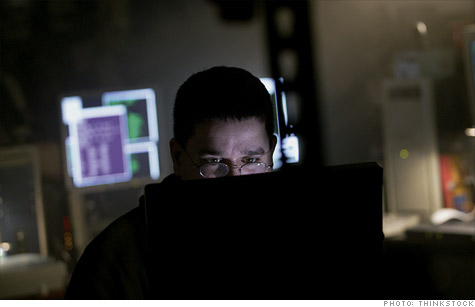
NEW YORK (CNNMoney) -- Anonymous has struck again.
In the hacktivist group's biggest attack to date, thousands of people teamed up and temporarily blocked access to the websites of the U.S. Department of Justice, the FBI, the Copyright Office, the Motion Picture Association, the Recording Industry Association, and several other music industry sites on Thursday. The attack came in retaliation for the DOJ's shuttering of Megaupload, a popular content site that hosted a large collection of pirated media.
The FBI said it is investigating the source of the attacks.
The name Anonymous pops up in the media every month or so, usually after the group knocks a website offline or releases private information snatched through hack attacks on those it deems enemies.
The stunts are often accompanied by the posting of ominous YouTube videos. Their common motifs include people wearing Guy Fawkes masks and a computerized voice intoning: "We are Anonymous. We are legion. We do not forgive. We do not forget."
But who are the people behind the masks? And what do they want?
Defining who "they" are is difficult. Anonymous is not an organized collective of like-minded hackers. Rather, it's a banner that many different hacktivist groups rally behind in an attempt to gather enough support to take down an opponent.
Those opponents are varied, and they have included Wall Street banks, Scientologists, cybersecurity firms and government bureaucracies, among others.
The Anonymous subculture attracts mostly young men with a decent but limited knowledge of hacking. They tend to fight against government and corporate actions they deem to limit freedom of speech.
"Anonymous is a brand -- not only a brand, but an open-source brand, which anyone can co-opt, use it when it's convenient and discard when it's done," said Greg Hoglund, CEO of security firm HBGary. "It's not even fair to say Anonymous is a leaderless organization, because there is no organization. It's not one static group."
Not all Anonymous groups think or act the same. Notably, one group attacked the New York Stock Exchange website in October in support of the Occupy Wall Street protests, while another influential faction -- also calling itself Anonymous -- urged the attackers to stand down. A back-and-forth debate raged across Twitter, with various wings of Anonymous alternately cheering and decrying the planned attack.
Even in Thursday's massive attack, there was some dissent. One frequent coordinator of Anonymous actions -- known on Twitter as @AnonyOps -- said Thursday that "the irony was not lost" on him that hacktivists were cutting off access to sites they oppose in the name of freedom of speech. He blasted the move as "censorship."
Security industry experts generally don't consider Anonymous a major player in the world of cybercrime.
The group's attacks are flashy but brief. When the collective takes aim, its target websites tend to go down -- and then, after a few hours, they come back up. Anonymous' main tactic is what's called a distributed denial of service attack, which directs huge amounts of Web traffic at a target website. That overwhelms that site's servers and effectively shuts it down.
Anonymous' DDoS attacks have been responsible for taking down websites of the CIA, Visa (V, Fortune 500), MasterCard (MA, Fortune 500) and several News Corp. (NWS) newspaper sites.
Sometimes Anonymous does escalate to actual hacking. By exploiting security holes, the group has been able to steal low-level information from the Senate and Arizona state police websites, as well as data from major corporations like Sony (SNE), Bank of America (BAC, Fortune 500) and Nintendo.
On Thursday, an Anonymous activist released a file filled with information about former Senator Chris Dodd -- now the head of the Motion Picture Association -- and his family. All of the information in it was fairly innocuous and could have been gathered from public data sources.
Anonymous has had a few public blunders. One group organized an unsuccessful boycott of PayPal. Another failed to take down Amazon.com (AMZN, Fortune 500), despite pledging an attack after a Wikileaks-related fight.
The point of Anonymous' actions is to call attention to themselves and their causes. They're the graffiti artists of the Internet -- annoying, perhaps, but a real threat? Not really.
"Anonymous is like a jewelry thief that drives through a window, steal jewels, and rather than keep them, waves them around and tosses them out to a crowd," said Paul Asadoorian, an independent security consultant. "They're very noisy, low-grade crimes." ![]()